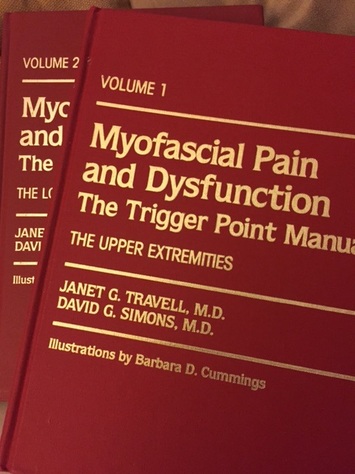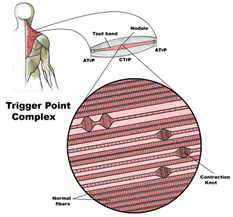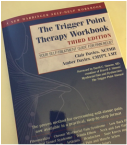The first time I heard about trigger points was over a decade ago. I didn’t know what they were but was told, by my fitness director, that they were the causes of muscle tightness and myofacial pain. Myo what?! The tragic thing about trigger points is that we have all experienced them and have suffered as a result.
Unfortunately, it took me few more years to figure out what trigger points were. I was able to really piece it together when Kate bought me, for my birthday, the books Myofascial Pain and Dysfunction Part 1 and Part 2 by Drs. Janet Travell and David Simons.

It doesn’t get any better than this when your wife get you these babies for your B-day

Simply put, trigger points are tight bundles of muscle fibers that we can usually feel on our bodies in the form of muscle knots and when pressed elicit pain. Surprisingly, they are the source of about 75% of our pain. Typically, you can find these knots on any muscles you overuse and abuse. The most common place you find them is on the traps. This reminds of a bartender we at Cinghiale while celebrating our anniversary a few months ago. He was talking to Kate about her jaw pain from singing opera in her younger days. The bartender related that he was a musician himself and suffered from chronic shoulder pain from playing the harp professionally. What Kate and the bartender had in common was that they both suffered from trigger points. He said that the trigger point in his shoulder was so bad that he was unable to play his instrument for few years until he was able to treat them.
Personally, I’ve had my bouts with trigger points as well. A few months ago, when I was rocking Mr. Man till 5 in the morning, I developed one on the upper inner edge of my left shoulder blade (for those anatomy and phys majors, it was on the insertion of the levator scapulae). It was so bad that I could hardly lift my left arm and got terrible headaches from it. My love affair with trigger points did not end there. Currently, I am experiencing some bad lower back pain from trigger points. For awhile, I mistakenly was trying to treat the location of the pain rather than its source so I would massage or foam roll my lower back till the cows came home. The problem was that the pain would go away for a bit, but would always come back later. Eventually, I was able to figure out the real source of this pain. The lower back pain was actually emanating
not from the lumber spine region, but, from my tight hip flexors (illopsoas), which I had to self-treat from the front of the hips and near the belly button region. Since I made this discovery, I’ve found that my self-treatment and the stretching of my hip flexors has done wonders for my stiff and painful lower back.
The other problem these knots cause is dysfunction of the muscle in itself. When a muscle has knots in them, it is unable to lengthen to its full range of motion (ROM) causing us to feel “tight”. Further, these knots make the muscle weak and less capable of contracting. So the key points in dealing with trigger points are: 1) identify and 2) consistently self-treat them, which can do wonders for how you feel and function.

If you want to learn more about trigger points, you should look up the book
The Trigger Point Therapy Workbook written by a former piano tuner turned massage therapist Clair Davies who has made the information much more accessible to the lay audience.
If you want professional help with trigger points, you can contact my licensed massage therapist Erin here.




0 responses to “Trigger Points”